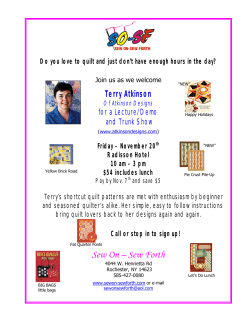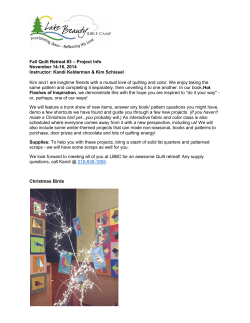
Scrappy Rail Fence Quilt
Scrappy Rail Fence Quilt Block Size: 6" Finished Size: 48” x 60” What do I need? 2” strips of scrap fabric (about 2 yards of 44" wide fabric) 1 ½ yards fabric for border ½ yard fabric cut into 2--1/2" strips for binding Backing fabric 54” x 66” Batting 54” x 66” Rotary cutter, ruler (at least 2” X 6 ½”), and mat Scissors, thread to match How do I do it? Cut your 2” strips at 6 ½” intervals to make 192 pieces. Sort strips into three color value piles—really dark (48 pieces), really light (48 pieces), and medium (96 pieces). Using very dark and very light values will create a more distinct rail fence pattern on the finished top. Sew each dark piece to one medium piece. Sew each light piece to one medium piece. Press seams toward the darker fabric in each group. Now sew one dark/medium unit to each light/medium unit together, matching the medium strips (light and dark toward the outside of the unit). Press seams toward the darker fabric. Check the width of your strip unit. It should measure 6 1/2". If so, you are ready for the next step. If you get a different measurement, say, 6 1/4", you need to trim your strip units to that length. These strip units need to be square. Arrange four strip units together as shown to make the block. Sew the units together in pairs; press seams toward the unpieced side. Sew the two pairs together to make the block. Press seams to one side. Arrange blocks three across and four down as shown in picture of quilt. Sew together in rows, then sew rows together to make quilt top. Cut border fabric lengthwise into four 7” wide strips. Measure longer side of quilt in three places (sides and middle) to find the average length. Cut two pieces of the 7” wide border fabric strips the same length as this measurement. Sew border to side of quilt, then press seams away from center. Now measure across width of quilt (including the border you just applied). Cut two pieces of 7” wide border fabric the same length as this measurement. Sew borders to top and bottom of quilt, then press seams away from center. At this point, trim the entire border to measure 6 ¼” wide. Layer quilt top, batting, and backing and secure with pins or basting stitches if needed. Tie the quilt, or hand- or machine-quilt the quilt. Apply binding. How should I quilt this project? With this much fabric action, your quilting will take a supporting role. If you are hand-quilting, you may quilt in the ditch or ¼” from seam lines. If you are machine quilting, you may also quilt in the ditch between the block units. Another easy finish is an all-over meander or pantograph. Hurry-up Hint: Are your strips between 6 ½” and 8” long? Don’t bother to cut them as directed in step #1. Simply sew the strips together, matching one end and leaving the other end ragged. After you have sewn four strips together, press the pieces, then trim the entire piece to 6 ½” x 6 ½” (or use the measurement you get for the actual width of your sewn strips to trim). If the leftover bits that you cut away are large enough, trim them and set them aside as a trim for a border or the seeds of a mini quilt.
© Copyright 2025





















